
RESEA R C H Open Access
A randomized phase II trial of mitoxantrone,
estramustine and vinorelbine or bcl-2 modulation
with 13-cis retinoic acid, interferon and paclitaxel
in patients with metastatic castrate-resistant
prostate cancer: ECOG 3899
Robert S DiPaola
1*
, Yu-Hui Chen
2
, Mark Stein
1
, David Vaughn
3
, Linda Patrick-Miller
1
, Michael Carducci
4
,
Bruce Roth
5
, Eileen White
6
, George Wilding
7
Abstract
Background: To test the hypothesis that modulation of Bcl-2 with 13-cis retinoic acid (CRA)/interferon-alpha2b
(IFN) with paclitaxel (TAX), or mitoxantrone, estramustine and vinorelbine (MEV) will have clinical activity in men
with metastatic castrate-resistant prostate cancer (CRPC).
Methods: 70 patients were treated with either MEV (Arm A) in a 3-week cycle or CRA/IFN/TAX with an 8-week
cycle (Arm B). Patients were assessed for response, toxicity, quality of life (QOL), and the effect of treatment on Bcl-
2 levels in peripheral blood mononuclear cells (PBMC).
Results: The PSA response rates were 50% and 23%, measurable disease response rates (CR+PR) 14% and 15%,
and median overall survival 19.4 months and 13.9 months on Arm A and Arm B respectively. Transient grade 4
neutropenia occurred in 18 and 2 patients, and grade 3 to 4 thrombosis in 7 patients and 1 patient in Arm A and
Arm B respectively. Patients on Arm B reported a clinically significant decline in QOL between baseline and week
9/10 (.71 s.d.), and a significantly lower level of QOL than Arm A (p = 0.01). As hypothesized, Bcl-2 levels decreased
with CRA/IFN therapy only in Arm B (p = 0.03).
Conclusions: Treatment with MEV was well tolerated and demonstrated clinical activity in patients with CRPC.
Given the adverse effect of CRA/IFN/TAX on QOL, the study of other novel agents that target Bcl-2 family proteins
is warranted. The feasibility of measuring Bcl-2 protein in a cooperative group setting is hypothesis generating and
supports further study as a marker for Bcl-2 targeted therapy.
Trial Registration: Clinical Trials Registration number: CDR0000067865
Background
It was estimated that approximately 200,000 new patients
were diagnosed with prostate cancer, and 40,000 died
from their disease in 2008 [1]. Standard hormonal ther-
apy or chemotherapy is limited in effectiveness against
metastatic prostate cancer because of the development of
tumor resistance. Options for improved survival in
patients with castrate-resistant prostate cancer (CRPC)
are limited with only data clearly established for the use
of docetaxel chemotherapy [2].
An important mechanism of tumor resistance, which
can be exploited therapeutically, is the over-expression of
Bcl-2. The over-expression of Bcl-2 is implicated as a
cause of hormonal and chemotherapy resistance and has
been shown to increase with castration in prostate cancer
[3,4]. Prior studies conducted by our group and other
investigators demonstrated that retinoids can decrease
expression of Bcl-2, that the combination of 13-cis reti-
noic acid (CRA) and interferon (IFN) enhanced the effect
* Correspondence: dipaolrs@umdnj.edu
1
Department of Medicine, The Cancer Institute of New Jersey, UMDNJ-
RWJMS, New Brunswick NJ, USA
DiPaola et al.Journal of Translational Medicine 2010, 8:20
http://www.translational-medicine.com/content/8/1/20
© 2010 DiPaola et al; licensee BioMed Central Ltd. This is an Open Access article distributed under the terms of the Creative Commons
Attribution License (http://creativecommons.org/licenses/by/2.0), which permits unrestricted use, distribution, and reproduction in
any medium, provided the original work is properly cited.

of paclitaxel chemotherapy, and that the combination can
be safely administered in phase I studies [5-7]. More
recently, our group and other investigators have studied
novel BH3 domain mimetics such as AT101 and
ABT263, which modulate multiple Bcl-2 family proteins,
and are being tested in early clinical studies [8-10].
The development of novel chemotherapeutic combina-
tions to overcome tumor resistance may also be impor-
tant [11,12]. In this regard, previous data demonstrated
activity with estramustine-based combinations and the
activity of combined navelbine and mitoxantrone, sup-
porting the testing of combination therapy with estra-
mustine, mitoxantrone, and vinorelbine in patients with
CRPC. One study demonstrated a potential clinical ben-
efit to adding estramustine with vinorelbine as second
line therapy in CRPC [13]. Another study conducted by
the Hellenic Cooperative Oncology Group, evaluated the
safety and activity of the combination in CRPC and
found evidence of activity including complete responses
in measurable disease [14].
Clearly, further efforts are needed to understand and
target mechanisms of tumor resistance. In the current
study, two regimens are tested in a randomized phase II
selection design study in an attempt to develop various
approaches to abrogate resistance in CRPC. Therefore,
the results of this study using CRA/IFN with weekly
paclitaxel (Arm B of this randomized phase II study)
may be helpful to this area of drug development to
determine the activity of the combination, and to under-
stand peripheral blood mononuclear cell Bcl-2 protein
expression as a potential biomarker for future studies.
Given the possibility of estrogen effect on Bcl-2 expres-
sion, arm A of our study was conducted to both confirm
the activity of the combination of estramustine, mitox-
antrone and vinorelbine, as well as to assess the effect
on Bcl-2 protein in peripheral blood mononuclear cells,
as planned for Arm B of the study. Additionally, patients
with CRPC are at risk of replacing disease related symp-
toms with treatment associated symptoms. Thus, evalua-
tion of patients’symptoms and QOL was an important
endpoint in the study [15].
Methods
Patients
To be eligible for this study, patients were required to
have an ECOG performance status of 0, 1, or 2, have
histologically proven adenocarcinoma of the prostate
gland, and evidence of progressive metastatic disease
within 4 weeks of study entry. Patients with an elevated
serum alkaline phosphatase or PSA level as the only evi-
dence of disease were ineligible. Patients with only bone
metastases were required to have a PSA level of ≥20
ng/ml. Patients with soft tissue metastases and/or visc-
eral disease were required to have either measurable
disease or a PSA level of ≥20 ng/ml. Patients were
required to have prior treatment with bilateral orchiect-
omy or other primary hormonal therapy with evidence
of treatment failure (patients who had not undergone
bilateral orchiectomy were required to continue LHRH
agonist therapy while receiving protocol therapy). Fluta-
mide or Nilutamide must have been discontinued at
least 4 weeks prior to randomization, and bicalutamide
at least 6 weeks prior to randomization, with evidence
of progressive disease. Patients could not have had prior
chemotherapy or prior Strontium 89, Samarium 153, or
other radioisotope therapies. Patients must have had
adequate bone marrow function, defined as WBC ≥
4000/mm
3
, granulocytes ≥2000/mm
3
, platelet count ≥
100,000/mm
3
, bilirubin ≤1.5 mg/dl, SGOT (AST) and
SGPT (ALT) ≤2 times the institutional upper limit of
normal, creatinine ≤2.0 mg/dl or a calculated creatinine
clearance ≥50 ml/min, LVEF ≥50% as proven by
MUGA within 4 weeks of study entry, no active angina
pectoris, or known heart disease of New York Heart
Association Class III-IV. Patients must have had no his-
tory of myocardial infarction within 6 months of study
entry and no history of deep venous thrombosis. The
requirement of MUGA evaluation for LVEF was added
in Addendum 2 (December 2001).
Study Design
This study was conducted by the Eastern Cooperative
Oncology Group (ECOG), required institutional review
board approval at each ECOG institution, and required
an informed consent for each patient. Patients were ran-
domly assigned to either Arm A or B. Patients rando-
mized to Arm A received vinorelbine 25 mg/m
2
intravenously on days 2 and 9, followed by mitoxantrone
10 mg/m
2
intravenously on day 2 and estramustine 280
mg orally twice a day on days 1 through 5 of a 3-week
cycle. Patients were continued on treatment until evi-
dence of disease progression, unacceptable toxicity or to
a cumulative mitoxantrone dose of 140 mg/m
2
. Patients
with prior pelvic irradiation were treated with a 25%
dose reduction of mitoxantrone (reduced dose =
7.5 mg/m
2
). Patients randomized to Arm B received
13-cis retinoic acid (CRA) 1 mg/kg orally, and inter-
feron-alpha2b (IFN) 6 MU/m
2
subcutaneously, each
administered on days 1 and 2 of each week, followed by
paclitaxel 75 mg/m
2
intravenously on day 2 of each
week with an 8-week cycle (Arm B). Each 8-week course
consisted of 6 weeks of treatment followed by a 2-week
rest. Treatment was continued until evidence of disease
progression or unacceptable toxicity. As prophylaxis for
hypersensitivity reactions, patients were premedicated
with dexamethasone 20 mg, cimetidine (or ranitidine)
300 mg (50 mg), and benadryl 50 mg intravenously 30
minutes prior to each dose of paclitaxel. All dosing was
DiPaola et al.Journal of Translational Medicine 2010, 8:20
http://www.translational-medicine.com/content/8/1/20
Page 2 of 9

based on patients’actual weight at the beginning of each
cycle. Conditions for dose modification in the case of
toxicity were specified in the protocol.
Efficacy and Safety
Response and progression were assessed according to
RECIST and were determined by investigator assessment
of radiographs and PSA. All toxicities were graded
according to the Common Toxicity Criteria (CTC) ver-
sion 2.0. Three self-reported measures of QOL were
completed by patients in both arms: the Functional
Assessment of Cancer Therapy, Prostate Cancer Version
4 (FACT-P), the Brief Pain Inventory- Short Form (BPI),
and the Schwartz Cancer Fatigue Scale (SCFS). FACT-P
consists of 27 core items, which assess patient function
(FACT-G) and a 12-item prostate cancer subscale (PCS)
to assess symptoms and problems specific to prostate
cancer. In addition, the 26-item Trial Outcome Index
(TOI) was computed by combining the physical well-
being, functional well-being, and PCS subscales. Pain
intensity and interference with functioning were assessed
with the BPI. All patients completed the QOL assessment
at baseline. QOL was also assessed for Arm A patients on
day 2 of cycles 2, 4, and 6 as well as completion of treat-
ment; for Arm B patients, on day 22 of cycle 1 and day 1
of cycles 2 and 3 and completion of treatment. In the
case of missing responses in the FACT measures, if at
least half of the subscale items were answered, the sub-
scale score was the average of the completed items multi-
plied by the number of items in the subscale. Item
responses are averaged across the BPI to indicate pain
intensity and interference. Higher scores for BPI indicate
worse pain or more interference; higher scores for the
FACT and SCFS indicate better quality of life.
Bcl-2 assessment
Peripheral blood was collected on day 1 and day 3 of
the first cycle of treatment to analyze mononuclear cell
Bcl-2 levels, as previously described [5]. An actin control
was used to adjust for the differences in the amount of
protein loaded. A comparison between the Bcl-2 levels
on day 1 and day 3 of the first cycle was done to deter-
mine the effect of protocol treatment on Bcl-2 levels. A
patient with a 50% or greater decrease in western band
intensity on densitometer measurement was considered
to have a Bcl-2 response.
Statistical Design and Data Analysis
Patients were equally randomized to either of the two
treatment regimens and stratified by extent of disease
(measurable disease vs. non-measurable disease and ele-
vated PSA). The primary endpoint was the proportion
of patients responding by 6 months. PSA response was
defined as PSA decline from baseline value by ≥50%, or
normalization of PSA (<0.2 ng/mL), confirmed by a sec-
ond measurement at least 1 week later. An underlying
true response rate of 40% was considered evidence that
the treatment merited further study. On the other hand,
an underlying true response rate of 10% would be of no
clinical interest.
A two-stage accrual plan was employed for this study.
First, 7 eligible patients per arm were to be registered to
the study and assessed for PSA response at 6 months.
Accrual would continue while these patients were fol-
lowed for the primary endpoint. Upon assessment, if 1 or
more of the 7 eligible patients responded, accrual would
continue to 30 eligible patients (35 total) per arm. If none
of the first 7 eligible patients demonstrated response, the
study would halt and the other patients accrued by this
time would be assessed. A stochastic curtailment algo-
rithm was used to guide decision-making. For each
potential number of patients registered at the time
response assessment among the first 7 eligible patients
was complete, the number of stage 1 responses required
to reopen accrual (out of all patients enrolled at that
time) was identified in the protocol, based on an ad hoc
rule, along with the corresponding probability of stop-
ping early under the null hypothesis (response rate of
10%), and the probabilities of rejecting the treatment
under the null and alternative hypotheses. If 7 or more of
the 30 eligible patients responded by 6 months, we would
conclude that the treatment warranted further study. The
probability of concluding that the treatment was effective
was at least 90 to 98% if the true response rate was 40%.
The probability of stopping early if the treatment was
ineffective (true response rate of 10% or less) was at least
48% and might be as high as 94%. If 7 responses were
observed among the 30 eligible patients, the two-stage
90% confidence interval would be approximately 12% to
41%. If the total number of responses among the 30 eligi-
ble patients was 7 or more on a given arm, additional
patients with measurable disease would be enrolled, such
that the total number of patients with documented mea-
surable disease was 27 per arm, of whom 25 were eligible.
Following this second phase of accrual, the response rates
among patients with and without measurable disease and
their respective 90% confidence intervals would be com-
puted. The 90% confidence interval around the true
response rate among eligible patients with measurable
disease would be no wider than 36%.
Survival time was defined as the time from study entry
until death or date last known alive. Progression-free
survival was defined as the time from registration to
first progression of any applicable type (measurable dis-
ease, PSA, or bone) or death, whichever came first (for
patients who progressed or died), or time from registra-
tion until date last known progression-free (for patients
who are alive without progression). For patients with
DiPaola et al.Journal of Translational Medicine 2010, 8:20
http://www.translational-medicine.com/content/8/1/20
Page 3 of 9

measurable disease who did not progress, time to pro-
gression was censored at the last measurable disease
assessment or bone scan, whichever came first. For
patients without measurable disease who did not pro-
gress, time to progression was censored at the last bone
scan or last PSA measurement, whichever came first.
Descriptive statistics were used to characterize patients
at study entry. Patient demographics, adverse events,
and response rates were compared using Fisher’s exact
test. The method of Kaplan and Meier was used to char-
acterize overall survival and progression-free survival.
The stratified log rank test was used to test for differ-
ences in overall survival and progression-free survival by
treatment. The Wilcoxon signed-rank test was used to
test the differences in Bcl-2 levels between Day 1 Cycle
1 and Day 3 Cycle 1. All p-values are two sided.
In order to evaluate the effects of treatment on QOL,
changes in the FACT-P, TOI, BPI, and SCFS from base-
line to week 9/10 were calculated for each patient, and
evaluated using the Wilcoxon signed-rank test. Three
patients with measurable disease were stratified incor-
rectly to the non-measurable disease and elevated PSA
stratum (2 Arm A patients and 1 Arm B patient), while
1 Arm A patient without measurable disease was strati-
fied incorrectly to the measurable disease stratum. All
patients were analyzed according to their actual extent
of disease regardless of how they were stratified.
Results
Patient Characteristics
The study was activated on January 31, 2001 and com-
pleted on October 7, 2003 after reaching its accrual goal
of 70 patients. Eighteen main ECOG institutions con-
tributed patients to the study. Seven patients were ineli-
gible, and sixty-three patients were included in the main
analysis. Patient demographic factors and disease char-
acteristics of the eligible patients at study entry are pro-
vided in Table 1. Overall, the median age was 68 years
Table 1 Patient Characteristics
Arm A (n = 32) Arm B (n = 31) Total (n = 63)
n Percent n Percent n Percent
Age
Median 70 65 68
Range 50-89 45-80 45-89
Race
White 30 94% 28 90% 58 92%
Black 1 3% 3 10% 4 6%
Hispanic 1 3% 0 0% 1 2%
ECOG PS
0 15 47% 17 55% 32 51%
1 16 50% 12 39% 28 44%
2 1 3% 2 6% 3 5%
Extent of Disease
Measurable, Non-Osseous Disease Present 14 44% 13 42% 27 43%
Evaluable, Osseous Disease Present 28 88% 30 97% 58 92%
Evaluable, Non-Osseous Disease Present 13 41% 12 39% 25 40%
Elevated PSA 32 100% 30 97% 62 98%
Metastatic Disease
Lung 4 13% 4 13% 8 13%
Liver 3 9% 3 10% 6 10%
Bone 28 88% 29 94% 57 90%
Bone Marrow 0 0% 1 3% 1 2%
Pleura 1 3% 0 0% 1 2%
Other 11 34% 9 29% 20 32%
Prior Treatment
Orchiectomy 10 31% 7 23% 17 27%
Prostatectomy 17 53% 15 48% 32 51%
Other Surgery 19 59% 20 65% 39 62%
Radiation Therapy 18 56% 20 65% 38 60%
Hormonal Therapy 31 97% 29 94% 60 95%
Biologic Response Modifier 4 13% 2 6% 6 10%
DiPaola et al.Journal of Translational Medicine 2010, 8:20
http://www.translational-medicine.com/content/8/1/20
Page 4 of 9

with a range of 45 to 89 years. Most patients (95%) had
ECOG Performance Status of 0 or 1. About 90% of
patients were Caucasian. All patients had metastatic dis-
ease, most commonly in the bone (90%). Ninety-five
percent had been treated with hormonal therapy, and
27% had prior orchiectomy. As shown in Table 1, base-
line demographic and tumor characteristics were gener-
ally well balanced between the two arms, and no
significant difference between the two arms was found.
Adverse Events
Patients received a median of 5 and 2 cycles (15 and 16
weeks total) of protocol therapy on Arm A, which used
3-week cycles, and Arm B, which used 8-week cycles,
respectively. Forty-one percent were off treatment due
to progressive disease. Information about symptoms and
toxicities was collected at baseline as well as during and
following treatment. All patients who received protocol
therapy, regardless of eligibility, were evaluated for toxi-
cities. Table 2 shows toxicities experienced by patients
during therapy. Hemoglobin was the most frequently
occurring toxicity. Nineteen and five patients experi-
enced life-threatening toxicities on Arm A and Arm B,
respectively, and the most frequently observed Grade 4
toxicity was neutropenia. The proportion of patients
with Grade 3 or higher toxicity was significantly higher
on Arm A for leukocytes (p < 0.001), neutrophils (p <
0.001), and worst degree toxicity (p = 0.004).
Clinical and Biochemical Effect
The PSA response rates were 50% (90% CI: [34%, 66%])
on Arm A and 23% (90% CI: [11%, 38%]) on Arm B
among eligible patients. There were 16/32 and 7/31
responses on Arm A and Arm B, respectively. Although
the primary objective was not to compare the two treat-
ment arms, an additional intent-to-treat analysis of
response demonstrated a 51% (18/35) response rate in
arm A and 20% (7/35) response rate in arm B. Sixteen
patients were unable to be evaluated for PSA response.
Of the 63 eligible patients, 14 and 13 had measurable
disease at study entry on Arm A and Arm B, respec-
tively. Six patients were unable to be evaluated for
objective response. In patients with measurable disease,
no CR and 2 PRs were observed on both arms. The
overall response rates (CR+PR) among patients with
measurable disease were 14% on Arm A and 15% on
Arm B.
At the time of analysis, 60 patients have died and 3
patients are still alive among eligible patients. Median
follow-up among patients still alive is 59 months. Figure
1 shows overall survival by treatment. Median survival is
19.4monthsforArmAand13.9monthsforArmB.
There was no statistically significant difference in overall
survival by treatment while controlling for extent of
disease (p = 0.42), but the study was not powered to
detect such difference. Figure 2 shows progression-free
survival by treatment. Median progression-free survival
is 5.9 months for Arm A and 2.5 months for Arm B.
There was no statistically significant difference in pro-
gression-free survival across treatments after adjusting
for extent of disease (p = 0.34), but the study was not
powered to detect such difference.
Bcl-2 Levels
Among the 63 eligible patients, 18 and 16 patients had
Bcl-2 levels available on Arm A and Arm B, respectively.
For Arm A, the average Bcl-2/actin ratio was 0.88 and
1.32 on day 1 and day 3 of cycle 1, respectively, and the
difference was not significant (p = 0.47). For Arm B, the
average Bcl-2/actin ratio was 1.55 and 1.00 on day 1
and day 3 of cycle 1, respectively, and the difference was
statistically significant (p = 0.03). Although the number
assessed was small, no significant association was found
between Bcl-2 response and PSA response on either
arm.
Quality of Life
The primary QOL outcomes were assessed by the
FACT-P and the TOI. Changes from baseline to week
9/10 (day 2 of cycle 4 for Arm A and day 1 of cycle 2
for Arm B) are shown in Figure 3. In Arm A the change
in QOL measures (FACT-P and TOI) did not differ sig-
nificantlyfrombaselinetoweek9/10;theaverage
change in FACT-P (mean = 3.5; sd = 18.6) did not
represent a clinically meaningful difference between
baseline and week 9/10. For patients in Arm B, FACT-P
(p = 0.01) and TOI (p = 0.02) were significantly lower at
week 9/10 than baseline (mean = -9.8; 0.71 s.d.).
Changes in symptom measures (BPI and SCFS) were
non-significant in both arm A and Arm B; however, the
study was not powered to detect statistical significance
in these measures.
Discussion
We found that treatment with vinorelbine, mitoxantrone
and estramustine yielded a response rate suggesting clin-
ical activity in men with CRPC, and was well tolerated.
The combination of CRA/IFN and paclitaxel, in con-
trast, resulted in clinically meaningful decline in QOL,
warranting the study of other novel agents that target
Bcl-2 family proteins. Effects of therapy on PBMC Bcl-2
protein supports the feasibility of measuring Bcl-2 family
proteins in a multi-institution cooperative group setting.
The treatment of CRA/IFN and paclitaxel was
designed to modulate Bcl-2 mediated drug resistance
based on studies demonstrating that Bcl-2 over-expres-
sion is implicated as a cause of hormonal and che-
motherapy resistance in prostate cancer, and prior
DiPaola et al.Journal of Translational Medicine 2010, 8:20
http://www.translational-medicine.com/content/8/1/20
Page 5 of 9

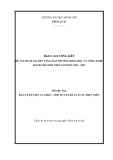
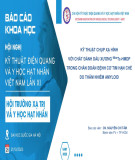

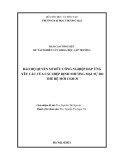
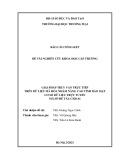
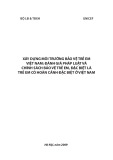
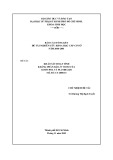
![Vaccine và ứng dụng: Bài tiểu luận [chuẩn SEO]](https://cdn.tailieu.vn/images/document/thumbnail/2016/20160519/3008140018/135x160/652005293.jpg)

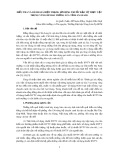





![Báo cáo seminar chuyên ngành Công nghệ hóa học và thực phẩm [Mới nhất]](https://cdn.tailieu.vn/images/document/thumbnail/2025/20250711/hienkelvinzoi@gmail.com/135x160/47051752458701.jpg)









